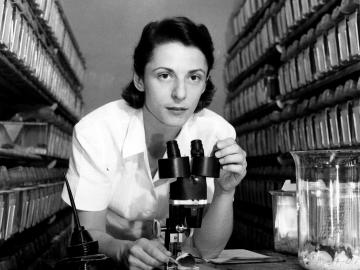
Filter News
Area of Research
News Topics
- (-) Bioenergy (15)
- (-) Biomedical (27)
- (-) Chemical Sciences (5)
- (-) Cybersecurity (7)
- (-) Grid (10)
- (-) Isotopes (14)
- (-) Physics (22)
- (-) Security (10)
- (-) Space Exploration (4)
- 3-D Printing/Advanced Manufacturing (33)
- Advanced Reactors (15)
- Artificial Intelligence (9)
- Big Data (12)
- Biology (6)
- Biotechnology (2)
- Buildings (1)
- Clean Water (3)
- Composites (4)
- Computer Science (53)
- Coronavirus (25)
- Critical Materials (3)
- Energy Storage (23)
- Environment (32)
- Exascale Computing (3)
- Frontier (1)
- Fusion (17)
- High-Performance Computing (3)
- Machine Learning (8)
- Materials (2)
- Materials Science (47)
- Mathematics (2)
- Mercury (2)
- Microscopy (13)
- Molten Salt (6)
- Nanotechnology (26)
- National Security (2)
- Neutron Science (45)
- Nuclear Energy (41)
- Polymers (12)
- Quantum Science (17)
- Summit (19)
- Transportation (22)
Media Contacts

Researchers at ORNL demonstrated that sodium-ion batteries can serve as a low-cost, high performance substitute for rechargeable lithium-ion batteries commonly used in robotics, power tools, and grid-scale energy storage.

Oak Ridge National Laboratory will partner with Cincinnati Children’s Hospital Medical Center to explore ways to deploy expertise in health data science that could more quickly identify patients’ mental health risk factors and aid in

A typhoon strikes an island in the Pacific Ocean, downing power lines and cell towers. An earthquake hits a remote mountainous region, destroying structures and leaving no communication infrastructure behind.

Researchers have developed a new process that could make it much cheaper to produce biofuels such as ethanol from plant waste and reduce reliance on fossil fuels.

Scientists at have experimentally demonstrated a novel cryogenic, or low temperature, memory cell circuit design based on coupled arrays of Josephson junctions, a technology that may be faster and more energy efficient than existing memory devices.

A select group gathered on the morning of Dec. 20 at the Department of Energy’s Oak Ridge National Laboratory for a symposium in honor of Liane B. Russell, the renowned ORNL mammalian geneticist who died in July.

To better determine the potential energy cost savings among connected homes, researchers at Oak Ridge National Laboratory developed a computer simulation to more accurately compare energy use on similar weather days.

A team of scientists has for the first time measured the elusive weak interaction between protons and neutrons in the nucleus of an atom. They had chosen the simplest nucleus consisting of one neutron and one proton for the study.

To learn more about interactions between drug molecules and micelles, Associate Professor Megan Robertson and graduate students Tyler Cooksey and Tzu-Han Li from the University of Houston (UH) are using neutrons at the Department of Energy’s (DOE’s) Oak Ridge National Laboratory (ORNL).

Scientists at the Department of Energy’s Oak Ridge National Laboratory have created a recipe for a renewable 3D printing feedstock that could spur a profitable new use for an intractable biorefinery byproduct: lignin.


